Kingdom Plantae Scientific name Echinacea Rank Genus | Higher classification Heliantheae | |
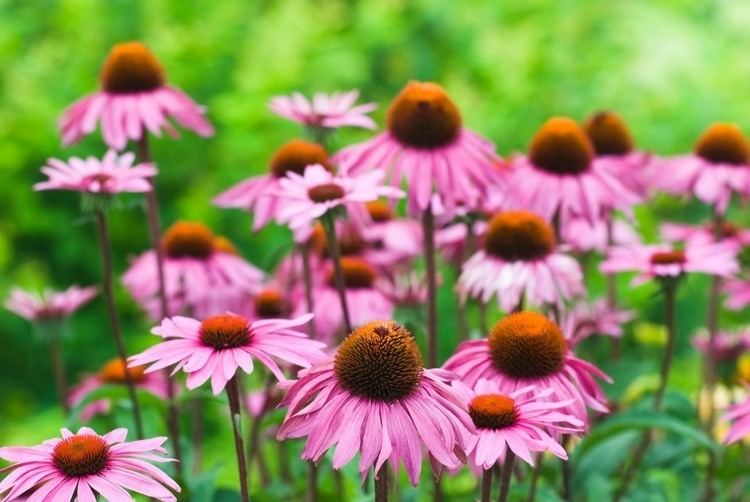 | ||
Lower classifications Purple coneflower, Echinacea angustifolia, Echinacea pallida, Echinacea paradoxa, Echinacea tennesseensis Similar Elderberry, Perforate St John's‑wort, Yarrow, Common sage, Daylily | ||
Echinacea growing tips from walters gardens
Echinacea /ˌɛkᵻˈneɪʃiə/ is a genus, or group of herbaceous flowering plants in the daisy family. The Echinacea genus has nine species, which are commonly called purple coneflowers. They are found only in eastern and central North America, where they are found growing in moist to dry prairies and open wooded areas. They have large, showy heads of composite flowers, blooming from early to late summer. The generic name is derived from the Greek word ἐχῖνος (ekhinos), meaning "hedgehog," due to the spiny central disk. These flowering plants and their parts have different uses. Some species are cultivated in gardens for their showy flowers. Echinacea purpurea is used in folk medicine. Two of the species, E. tennesseensis and E. laevigata, are listed in the United States as endangered species.
Contents
- Echinacea growing tips from walters gardens
- Making plant medicine echinacea
- Description
- Research and marketing
- Common cold
- Cancer
- Side effects
- Children under 12 years old
- Pregnancy
- Lactation
- General precaution
- Other uses
- History
- References

Species:
Researchers at the Agricultural Research Service are using DNA analysis to help determine the number of Echinacea species. The DNA analysis allows researchers to reveal clear distinctions among species based on chemical differences in root metabolites. The research concluded that of the 40 genetically diverse populations of Echinacea studied, there were nine distinct species.

Making plant medicine echinacea
Description

Echinacea species are herbaceous, drought-tolerant perennial plants growing up to 140 cm or 4 feet, in height. They grow from taproots, except E. purpurea, which grows from a short caudex with fibrous roots. They have erect stems that in most species are unbranched. Both the basal and cauline (stem) leaves are arranged alternately. The leaves are normally hairy with a rough texture, having uniseriate trichomes (1-4 rings of cells) but sometimes they lack hairs. The basal leaves and the lower stem leaves have petioles, and as the leaves progress up the stem the petioles often decrease in length. The leaf blades in different species may have one, three or five nerves. Some species have linear to lanceolate leaves, and others have elliptic- to ovate-shaped leaves; often the leaves decrease in size as they progress up the stems. Leaf bases gradually increase in width away from the petioles or the bases are rounded to heart shaped. Most species have leaf margins that are entire, but sometimes they are dentate or serrate. The flowers are collected together into single rounded heads at the ends of long peduncles. The inflorescences have crateriform to hemispheric shaped involucres which are 12–40 mm wide. The phyllaries, or bracts below the flower head, are persistent and number 15–50. The phyllaries are produced in a 2–4 series. The receptacles are hemispheric to conic. The paleae (chaffs on the receptacles of many Asteraceae) have orange to reddish purple ends, and are longer than the disc corollas. The paleae bases partially surrounding the cypselae, and are keeled with the apices abruptly constricted to awn-like tips. The ray florets number 8–21 and the corollas are dark purple to pale pink, white, or yellow. The tubes of the corolla are hairless or sparsely hairy, and the laminae are spreading, reflexed, or drooping in habit and linear to elliptic or obovate in shape. The abaxial faces of the laminae are glabrous or moderately hairy. The flower heads have typically 200-300 fertile, bisexual disc florets but some have more. The corollas are pinkish, greenish, reddish-purple or yellow and have tubes shorter than the throats. The pollen is normally yellow in most species, but usually white in E. pallida. The three or four-angled fruits (cypselae), are tan or bicolored with a dark brown band distally. The pappi are persistent and variously crown-shaped with 0 to 4 or more prominent teeth. x = 11.
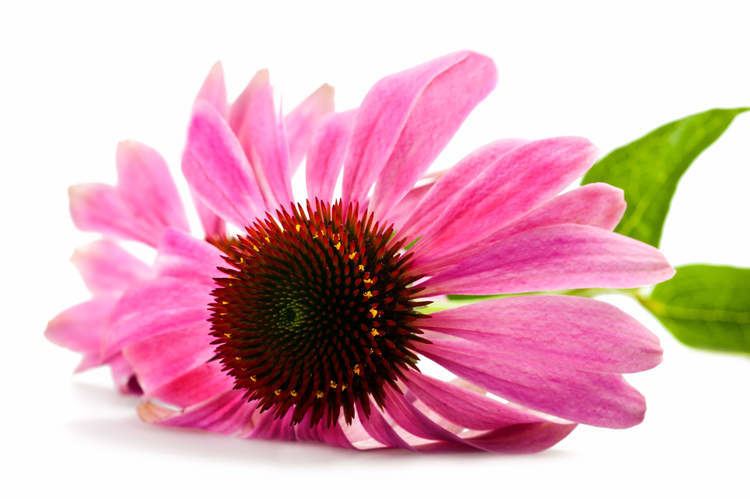
Like all members of the sunflower family, the flowering structure is a composite inflorescence, with rose-colored (rarely yellow or white) florets arranged in a prominent, somewhat cone-shaped head – "cone-shaped" because the petals of the outer ray florets tend to point downward (are reflexed) once the flower head opens, thus forming a cone. Plants are generally long lived, with distinctive flowers. The common name "cone flower" comes from the characteristic center "cone" at the center of the flower head. The generic name Echinacea is rooted in the Greek word ἐχῖνος (echinos), meaning hedgehog, it references the spiky appearance and feel of the flower heads.
Research and marketing
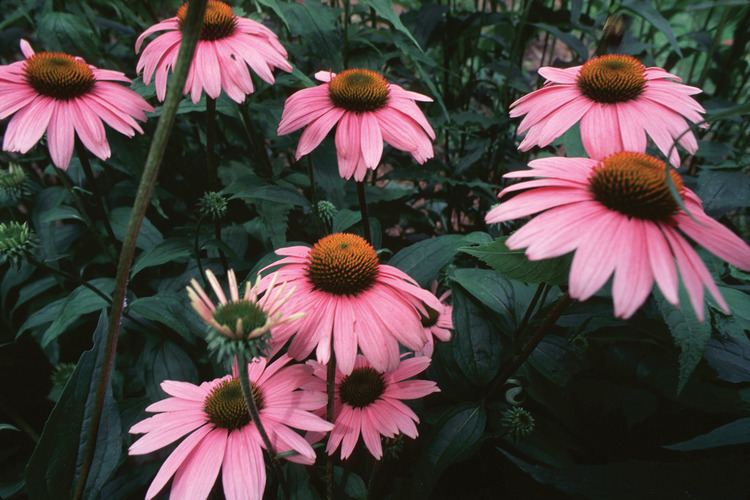
Echinacea products vary widely in composition. They contain different species (E. purpurea, E. angustifolia, E. pallida), different plant segments (roots, flowers, extracts), different preparations (extracts and expressed juice), and different chemical compositions which complicate understanding of a potential effect.
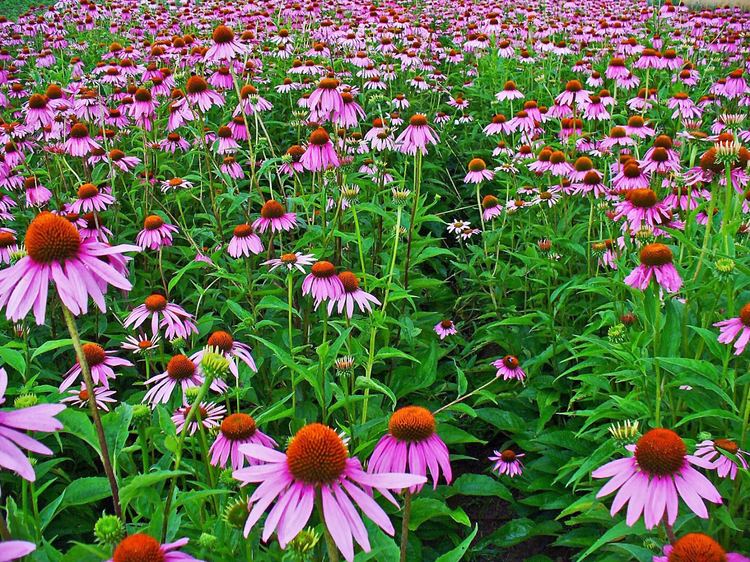
Well-controlled trials are limited and low in quality. Although there are multiple scientific reviews and meta-analyses published on the supposed immunological effects of echinacea, significant variability of echinacea products used among studies limited conclusions about effects and safety, consequently leading to non-approval of any health benefit or anti-disease activity.
Common cold
There is no conclusive evidence showing that echinacea products treat or prevent the common cold.
Cancer
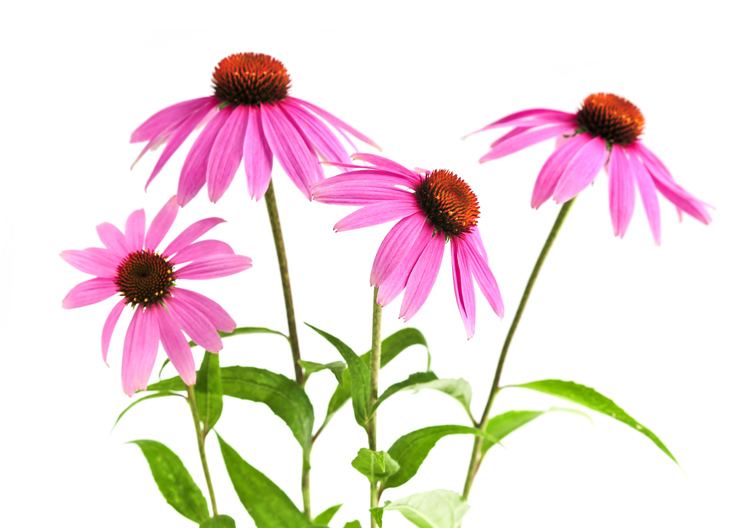
According to Cancer Research UK: "There is no scientific evidence to show that echinacea can help treat, prevent or cure cancer in any way. Some therapists have claimed that echinacea can help relieve side effects from cancer treatments such as chemotherapy and radiotherapy, but this has not been proven either."
Side effects
When taken by mouth, Echinacea does not usually cause side effects, but may have untoward interactions with various drugs prescribed for diseases, such as heart disease, bleeding and skin disorders.
One of the most extensive and systematic studies to review the safety of echinacea products concluded that overall, "adverse events are rare, mild and reversible," with the most common symptoms being "gastrointestinal and skin-related." Such side effects include nausea, abdominal pain, diarrhea, itch, and rash. Echinacea has also been linked to rare allergic reactions, including asthma, shortness of breath, and one case of anaphylaxis. Muscle and joint pain has been associated with echinacea, but it may have been caused by cold or flu symptoms for which the echinacea products were administered. There are isolated case reports of rare and idiosyncratic reactions including thrombocytopenic purpura, leucopenia, hepatitis, kidney failure, and atrial fibrillation, although it is not clear that these were due to echinacea itself.
Although there are no case reports of any drug interactions with echinacea, the absence of adequate safety information leads to caution in using echinacea when other medications are prescribed and clinical conditions exist.
As a matter of manufacturing safety, one investigation by an independent consumer testing laboratory found that five of eleven selected retail echinacea products failed quality testing. Four of the failing products contained levels of phenols below the potency level stated on the labels. One failing product was contaminated with lead.
Children under 12 years old
Research studies have shown that Echinacea purpurea juice extract is safe in children 2–11 years when used up to 10 days. 7% experienced a rash after taking echinacea, which suggested an allergic reaction. There is concern that the allergic reaction could be more severe in children. The European Herbal Medicinal Products Committee (HMPC) and the UK Herbal Medicines Advisory Committee (HMAC) recommended against the use of echinacea containing products in children under the age of 12. Manufacturers re-labelled all oral echinacea products that had product licenses for children with a warning that they should not be given to children under 12 as a precautionary measure.
Pregnancy
Although research has not found increased risk of birth defects associated with use of echinacea during the first trimester, it is recommended that pregnant women should avoid echinacea containing products until stronger safety supporting evidence becomes available.
Lactation
It is recommended that women breastfeeding should use caution with echinacea products due to insufficient safety information available.
General precaution
The U.S. Food and Drug Administration recommends precaution about using dietary supplements because some products may not be risk free under certain circumstances or may interact with prescription and over-the-counter medicines.
As with any herbal preparation, individual doses of echinacea may vary significantly in chemical composition. Inconsistent process control in manufactured echinacea products may involve poor inter- and intra-batch homogeneity, species or plant part differences, variable extraction methods, and contamination or adulteration with other products, leading to potential for substantial product variability.
Other uses
Some species of echinacea, notably E. purpurea, E. angustifolia, and E. pallida, are grown as ornamental plants in gardens. Many cultivars exist, and many of them are asexually propagated to keep them true to type.
They tolerate a wide variety of conditions, maintain attractive foliage throughout the season, and multiply rapidly. Appropriate species are used in prairie restorations. Echinacea plants also reseed in the fall. New flowers will grow where seeds have fallen from the prior year.
Echinacea extracts inhibited growth of three species of trypanosomatids: Leishmania donovani, Leishmania major, and Trypanosoma brucei.
History
Echinacea angustifolia was widely used by the North American Plains Indians for its supposed medicinal qualities. According to Wallace Sampson, its modern use for the common cold began when a Swiss herbal supplement maker was "erroneously told" that echinacea was used for cold prevention by Native American tribes who lived in the area of South Dakota. Although Native American tribes did not use echinacea for the common cold, some Plains tribes did use echinacea for cold symptoms. The Kiowa used it for coughs and sore throats, the Cheyenne for sore throats, the Pawnee for headaches, and many tribes including the Lakotah used it as a pain medication.
